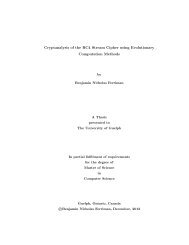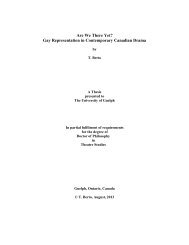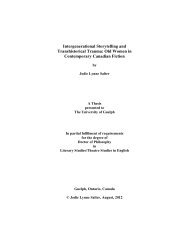University of Guelph thesis template - Atrium - University of Guelph
University of Guelph thesis template - Atrium - University of Guelph
University of Guelph thesis template - Atrium - University of Guelph
You also want an ePaper? Increase the reach of your titles
YUMPU automatically turns print PDFs into web optimized ePapers that Google loves.
CHAPTER ONE<br />
INTRODUCTION<br />
Was the labour <strong>of</strong> man esteemed as it ought to be,<br />
according to its usefulness, the weaver would hold<br />
a high claim for honour. 1<br />
The relationship between handloom weaver, John Campbell and his customers in<br />
nineteenth-century rural south-western Ontario is a model <strong>of</strong> the social and economic<br />
interdependence <strong>of</strong> rural communities. The following study addresses the essence <strong>of</strong> that<br />
relationship: Campbell’s production and his customers’ consumption <strong>of</strong> hand-woven cloth. The<br />
unassuming exchange <strong>of</strong> cloth for capital might be viewed solely as a business transaction<br />
between producer and consumer: the customer needed cloth, the weaver needed a livelihood.<br />
Due to the multi-stepped nature <strong>of</strong> pre-industrial textile production and Campbell’s expertise as a<br />
weaver, the relationship was far from simple and far from single-purposed. The role <strong>of</strong> producer<br />
and consumer crossed boundaries, as Campbell depended on the dyeing, spinning and rag sewing<br />
by his customers and his customers depended on Campbell to transform their homespun into a<br />
skillful end-product. 2<br />
In nineteenth-century Britain and North America, handloom weavers like Campbell<br />
persisted parallel to factory-produced cloth because <strong>of</strong> the appealing nature <strong>of</strong> the work <strong>of</strong> the<br />
handloom weaver, the independence that it afforded them and the continuing demand for handwoven<br />
cloth from the customer. 3<br />
Motivations and means for handloom weavers like John<br />
Campbell were fairly basic – they needed to make a living, they had a skill and they had a market<br />
1 Weaver’s magazine and literary companion. Volume II, no. 7. Jan. 1819 (Paisley, Scotland: John Neilson, 1819), 84.<br />
2 Gail F. Mohanty, Labor and Laborers <strong>of</strong> the Loom: Mechanization and Handloom Weavers, 1780-1840 (New York: Routledge, 2006),<br />
43.<br />
3 Cloth was being woven in factories such as the Rosamond Mill in Almonte, Ontario in 1857. Richard Reid, “The Rosamond Woollen<br />
Company <strong>of</strong> Almonte: Industrial Development in a Rural Setting,” Ontario History 75 (1983): 266-89. Cloth was woven on<br />
power looms at Frasher & Crashaws in Cobourg in 1849 and Andrew Paton’s woollen mill in Galt in 1855. Sedley Anthony<br />
Cudmore, Economics (Toronto, The Shaw Correspondence School, 1912), 14.<br />
1
















